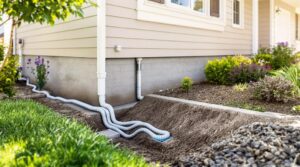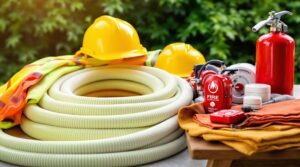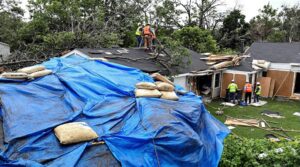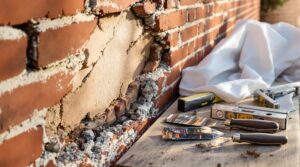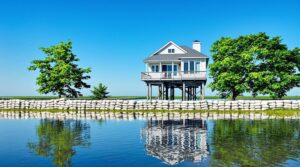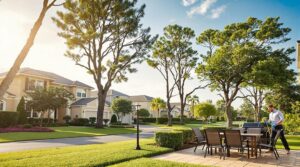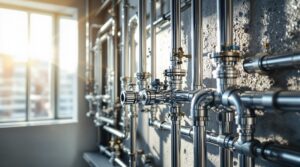Wildfire damage mitigation requires a thorough approach that incorporates defensible space zones, vegetation management, and home design and retrofitting. Effective emergency planning and evacuation routes are also essential. Homeowners should maintain a "lean, clean, and green" approach to vegetation management and guarantee that their insurance coverage includes wildfire damage. A well-executed mitigation plan can minimize property damage and loss. By understanding the key components of a wildfire mitigation plan, homeowners can take proactive steps to protect their property.
Key Takeaways
- Create defensible space zones around homes by managing vegetation and reducing flammable materials in zones 0-2.
- Regularly trim grass, remove dead plants, and prune overhanging branches to reduce fire hazards and prevent spread.
- Utilize fire-resistant materials for home exteriors, such as Class A fire-rated roofing and noncombustible fencing.
- Develop an emergency plan with designated evacuation routes, meeting points, and emergency contact information.
- Consider consulting a public adjuster for professional representation in navigating complex insurance claims post-wildfire.
Understanding Defensible Space Zones
When implementing wildfire damage mitigation strategies, understanding defensible space zones is a critical component of protecting homes and properties from fire hazards. A well-managed defensible space reduces the risk of home ignition by minimizing ember accumulation and creating a buffer zone between the home and surrounding flammable materials.
Vegetation management is key, with three distinct zones requiring specific practices: Zone 0 (0-5 feet), Zone 1 (5-30 feet), and Zone 2 (30-100 feet). Zone 1, for example, should be maintained with a "lean, clean, and green" approach, focusing on removing dead vegetation and maintaining 10-foot gaps between trees and shrubs.
Strategies for Managing Vegetation and Combustible Materials
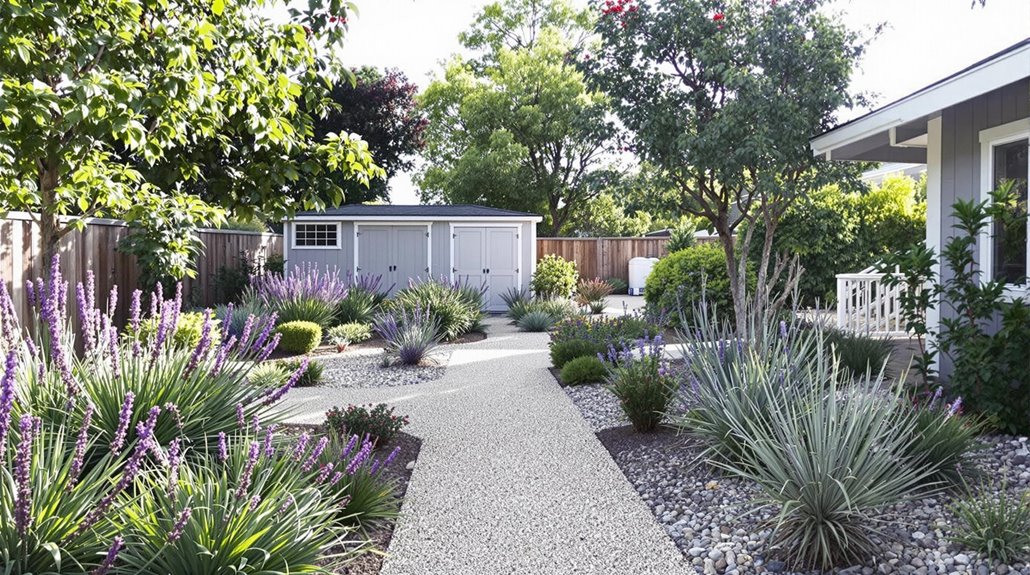
By creating a well-managed defensible space, homeowners can considerably reduce the risk of wildfire damage to their properties.
Effective vegetation management within this space involves regularly trimming grass and weeds to a maximum height of 4 inches, removing dead or dying plants, and pruning overhanging branches.
Fire-resistant landscaping also plays a critical role in minimizing ignition risks. Homeowners should select drought-tolerant plants and avoid highly flammable species such as eucalyptus and juniper.
Storing combustible materials like gasoline and propane at least 30 feet away from the home and frequently cleaning roofs, gutters, and decks to remove flammable debris can also decrease the likelihood of ember-related ignition, ultimately contributing to risk reduction in the Wildland Urban Interface.
Home Design and Retrofitting for Wildfire Mitigation
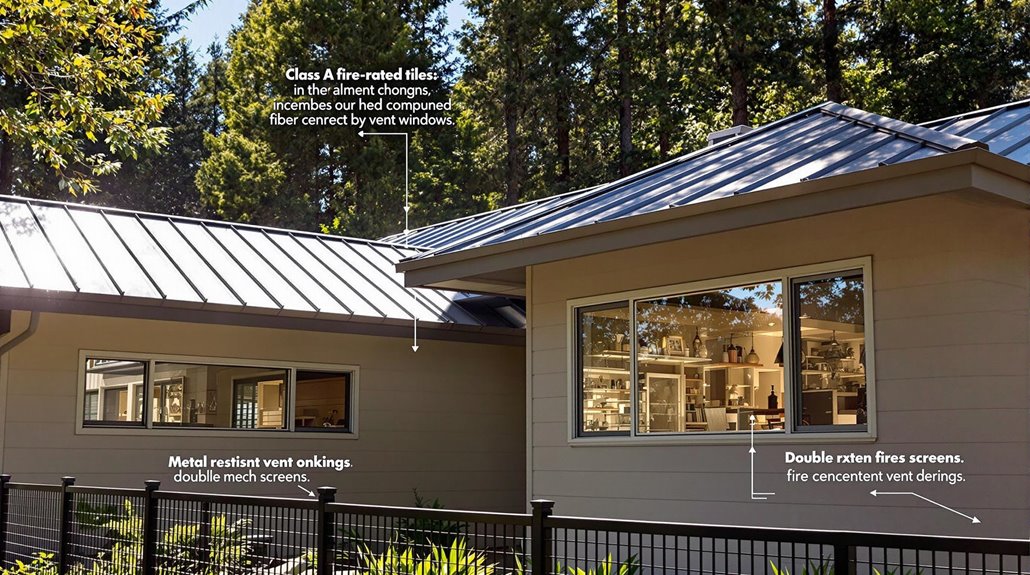
Incorporating wildfire mitigation measures into a home's design and retrofitting existing structures can greatly enhance their resilience to wildfire damage.
Home design considerations include utilizing Class A fire-rated roofing materials, such as asphalt, metal, or tile, which considerably reduce the likelihood of ignition from embers. Fire-resistant exterior materials, like stucco or fiber cement siding, can withstand flames and heat. Noncombustible fencing materials within the first five feet of the home create a barrier against fire embers.
Retrofitting homes with metal mesh screens over vents and openings prevents embers from entering the structure. Tempered or double-paned glass windows enhance structural ignitability resistance by minimizing the risk of breakage from heat exposure or debris.
These measures effectively contribute to wildfire mitigation, safeguarding homes in wildfire-prone areas.
Creating an Effective Emergency Plan and Evacuation Route
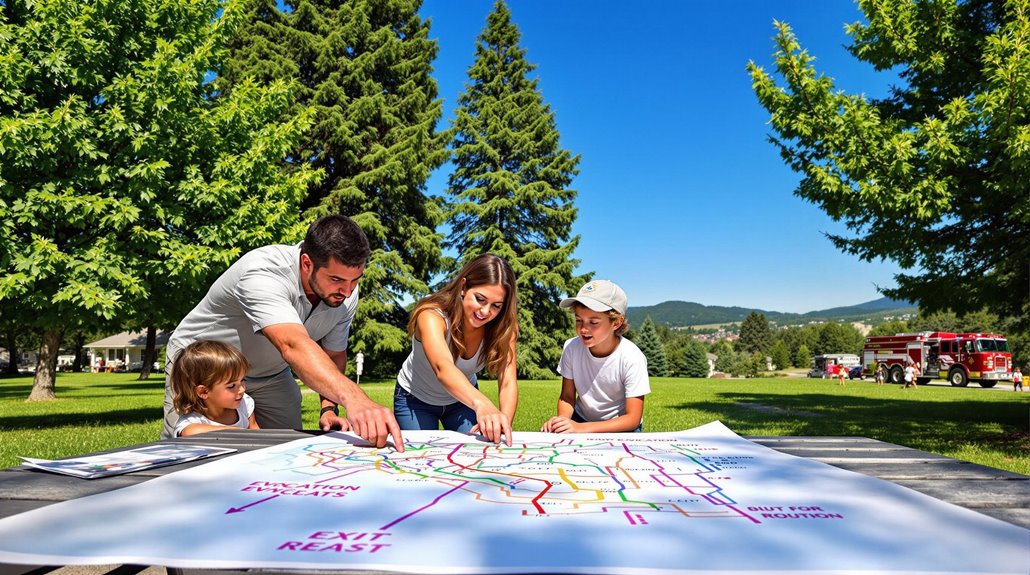
Numerous studies have shown that having a well-rehearsed emergency plan in place greatly increases the likelihood of a safe and successful evacuation during a wildfire event. A family emergency plan should include designated evacuation routes, meeting points, and emergency contact information. Regular practice of the emergency plan guarantees all family members are familiar with the evacuation procedures.
| Emergency Plan Component | Description | Importance |
|---|---|---|
| Evacuation Routes | Designated paths for evacuation | Guarantees swift exit |
| Meeting Points | Safe locations for family reunification | Prevents separation |
| Emergency Contact Information | Phone numbers and addresses of key contacts | Facilitates communication |
| Practice Emergency Plan | Regular rehearsal of evacuation procedures | Enhances preparedness |
| Secure Your Home | Turning off gas lines, closing windows and doors | Minimizes potential hazards |
Gathering Essential Supplies and Protecting Your Home With Insurance Coverage
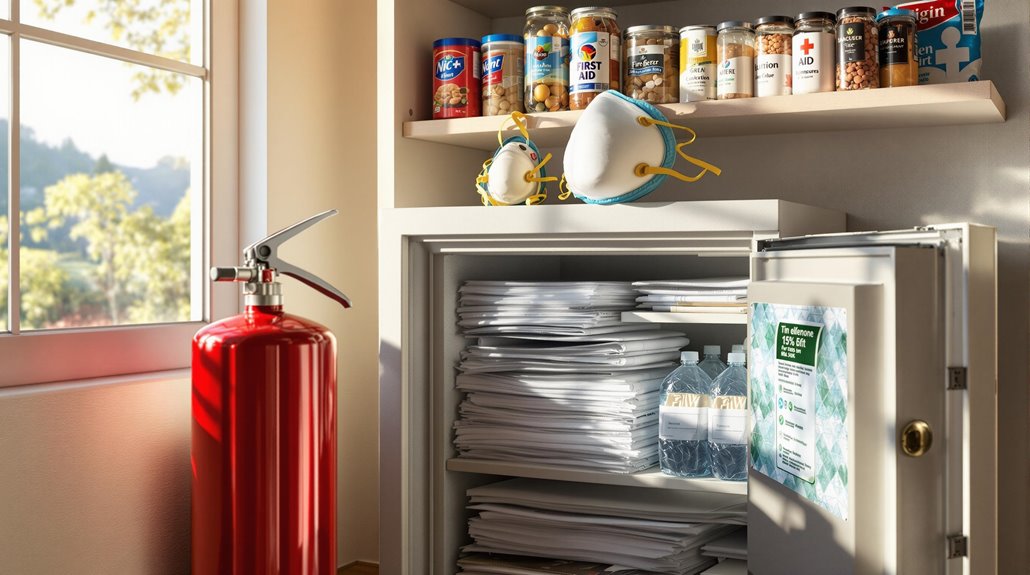
While having a well-rehearsed emergency plan in place is crucial for a safe and successful evacuation during a wildfire event, it is equally important to gather essential supplies and protect one's home with adequate insurance coverage.
Homeowners insurance that specifically covers wildfire damage can provide financial protection for property and possessions. To complement this, an emergency preparedness plan should include assembling essential supplies such as:
- N95 masks and a first aid kit to guarantee personal safety
- A fire extinguisher to combat small fires
- Non-perishable food and water to sustain individuals during evacuation
Important documents, including insurance policies, should be stored in a fireproof safe with digital copies kept in a secure location outside the home.
Regular review and update of insurance policies can help identify gaps in coverage.
Medical payments coverage through your homeowners insurance can help cover injuries to guests on your property during a wildfire emergency.
The Benefits Of Consulting A Public Adjuster
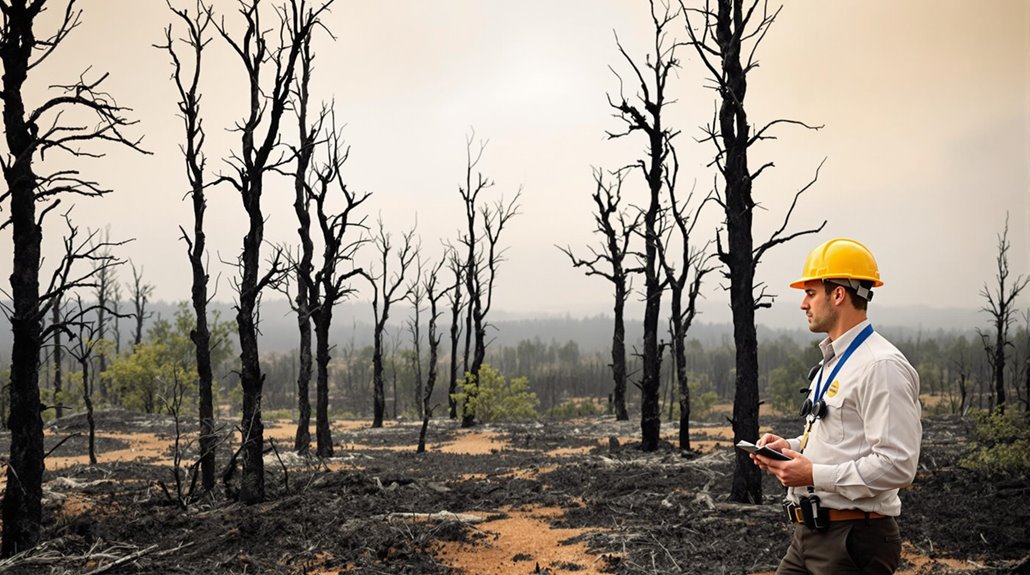
Consulting a public adjuster following a wildfire can provide policyholders with valuable expertise in maneuvering complex insurance claims.
A public adjuster's objective assessment of damage guarantees that all losses are accurately documented, streamlining the claim process and minimizing potential disputes.
Claims handled by public adjusters typically result in 800% higher settlements compared to those filed independently by policyholders.
Expertise In Insurance Claims
How can homeowners effectively navigate the intricate process of insurance claims following a devastating wildfire? Consulting a public adjuster can provide the necessary expertise in insurance claims, guaranteeing a fair settlement based on accurate loss assessment.
Public adjusters have extensive knowledge in evaluating property damage, which is essential for maximizing claim amounts.
Key benefits of hiring a public adjuster include:
- Expertise in evaluating property damage to guarantee accurate documentation of losses
- Objective perspective and advocacy for the homeowner's best interests during the claims process
- Time-saving and stress-reducing, as they handle paperwork, negotiations, and insurance company communication
Public adjusters often work on a contingency fee basis, incentivizing them to secure the highest possible compensation.
Their expertise in insurance claims provides homeowners with a valuable ally in the complex claims process.
Studies show that claims handled by public adjusters result in 800% higher settlements compared to those filed without professional representation.
Objective Damage Assessment
What constitutes an objective damage assessment in the aftermath of a devastating wildfire? A vital aspect of the recovery process, it involves evaluating the extent of damage to a home and identifying risk areas that may have been compromised.
Consulting a public adjuster is beneficial in this regard, as they provide expertise in appraising wildfire damage and maneuvering the complex claims process. By understanding insurance policies and thoroughly evaluating damage, a public adjuster can guarantee that homeowners receive fair compensation for their losses.
Their involvement in the claims process can also expedite the settlement, as they handle all communications and paperwork, ultimately reducing stress for the homeowner and maximizing recovery. This expertise is invaluable in securing a fair settlement. Studies show that working with public adjusters increases settlements by up to 800% compared to claims filed without professional representation.
Streamlined Claim Process
While traversing the aftermath of a wildfire can be a complex and intimidating experience for homeowners, enlisting the services of a public adjuster can appreciably alleviate the burden of managing the claims process.
A public adjuster's expertise in understanding insurance policy language and evaluating losses can streamline the claims process, reducing the time it takes to settle claims and providing quicker financial relief.
Some key benefits of consulting a public adjuster include:
- Specialized knowledge of insurance policy language to guarantee accurate documentation of eligible damages
- Expedited claims process through managed communications with the insurer
- Thorough damage assessment and detailed claim documentation to prevent underpayment or claim denials
Working with pre-vetted licensed adjusters through networks like PCAN ensures you receive professional representation from experienced professionals who maintain high ethical standards.
Higher Claim Payouts & Settlements
As statistics consistently demonstrate, consulting a public adjuster can yield substantially higher insurance claim payouts, often resulting in settlements that are 20-40% higher than those secured without professional representation.
A public adjuster's expertise in evaluating property damage and understanding policy language guarantees that all covered losses are accurately documented and claimed. They advocate on behalf of the policyholder throughout the claims process, negotiating with insurance companies to secure fair compensation for damages incurred during a wildfire. With contingency fee structures ranging from 5-20% of the final claim amount, public adjusters provide cost-effective representation compared to traditional legal services.
About The Public Claims Adjusters Network (PCAN)
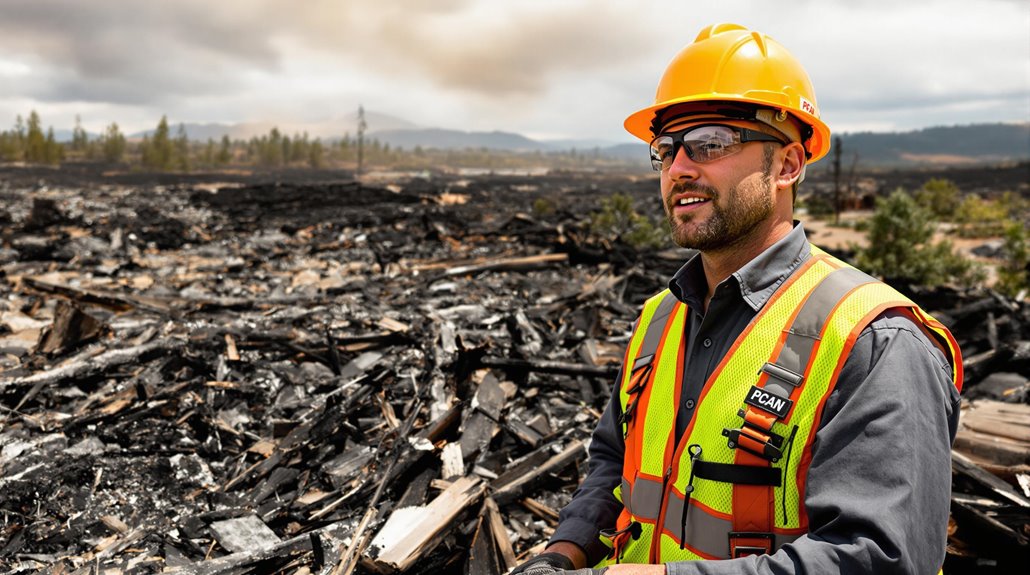
The Public Claims Adjusters Network (PCAN) comprises a nationwide coalition of meticulously vetted, state-licensed public adjusters with expertise in both residential and commercial property damage claims.
As a resource for policyholders, PCAN connects individuals with expert public adjusters who have undergone an intensive application and interview process to guarantee they are the best in their field.
Key aspects of PCAN's network include:
- Expertise in over 30 different claim types, including wildfire damage
- A presence in 40+ states, providing nationwide support
- Mandatory yearly audits of licenses and complaints to uphold the highest standards of ethics, morals, and professionalism
Their expert adjusters specialize in conducting thorough damage assessments to maximize potential settlement outcomes for property owners.
Frequently Asked Questions
How Do You Mitigate Wildfire Damage?
Mitigating wildfire damage requires drastic measures, starting with firebreak construction and creating a defensible space through vegetation management, using ember-resistant materials, and fostering community preparedness, emergency response, risk assessment, and informed insurance considerations to minimize devastation.
What Are the Mitigation Strategies for Wildfires?
Mitigation strategies for wildfires include firebreak construction, creating defensible space, vegetation management, promoting community awareness, conducting controlled burns, developing emergency planning, reviewing insurance considerations, and implementing fire-resistant landscape design to reduce ignition risks. Additionally, it is essential for communities to invest in fire damage restoration techniques to recover from the inevitably destructive impacts of wildfires. By incorporating these strategies, residents can ensure a more resilient landscape and reduce the long-term effects of fire threats. Ongoing education, workshops, and community drills can further enhance preparedness and response capabilities during wildfire season.
Is 320 Wildfire Mitigation Basics for Mitigation Staff?
Although some argue that standardizing wildfire mitigation basics is too rigid, mitigation staff require foundational knowledge of mitigation techniques, staff training, risk assessment, community involvement, equipment maintenance, firebreak construction, vegetation management, and regulatory compliance to effectively mitigate wildfire risks.
What Is a Wildfire Mitigation Plan?
A wildfire mitigation plan is a proactive document outlining wildfire prevention techniques, community preparedness plans, and risk assessment tools to reduce fire risk through vegetation management strategies, firebreak construction methods, emergency response coordination, and public education programs.
